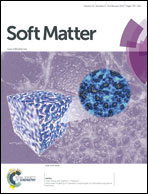Controllable surface morphology and properties via mist polymerization on a plasma-treated polymethyl methacrylate surface†
Abstract
Surface modification by grafting polymers on solid materials is an important strategy used to improve surface properties. This article reports that under appropriate conditions, very thin layers with desired morphologies may be constructed on a plasma-treated substrate by feeding a small quantity of a monomer with a mist stream carrying droplets produced from monomer solutions. We investigate the effects of process parameters that affect layer morphology, including exposure time to the mist stream, concentration of the monomer solution, and solvent selectivity. For a methyl methacrylate solution in ethanol, nanoparticles are uniformly grown with increasing monomer concentration or exposure time and finally form a porous layer at 3.65 mol L−1 for 30 min. Decreasing solvent polarity not only affects surface morphology, but also increases hydrophobicity of the resulting surface. With 2,2,3,4,4,4-hexafluorobutyl methacrylate as the monomer, SEM and AFM micrographs indicated that mist polymerization results in numerous microspheres on the activated surface. These experimental results were interpreted by a mechanism in terms of an in situ polymerization accompanied by a phase transformation of the resulting polymer. Specifically, plasma treatment provides highly active cations and radicals to initiate very rapid polymerization, and the resulting polymers are consequently deposited from the liquid onto the surface under phase transition mechanisms.


 Please wait while we load your content...
Please wait while we load your content...